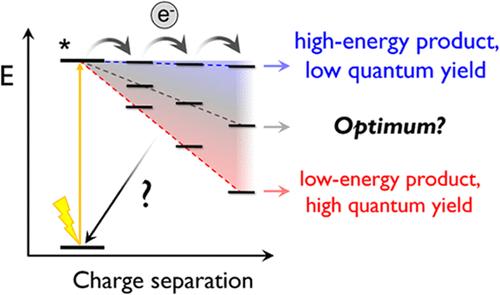Efficiency Limits of Energy Conversion by Light-Driven Redox Chains
IF 14.4
1区 化学
Q1 CHEMISTRY, MULTIDISCIPLINARY
引用次数: 0
Abstract
The conversion of absorbed sunlight to spatially separated electron–hole pairs is a crucial outcome of natural photosynthesis. Many organisms achieve near-unit quantum yields of charge separation (one electron–hole pair per incident photon) by dissipating as heat more than half of the light energy that is deposited in the primary donor. Might alternative choices have been made by Nature that would sacrifice quantum yield in favor of producing higher energy electron/hole pairs? Here, we use a multisite electron hopping model to address the kinetic and thermodynamic compromises that can be made in electron transfer chains, with the aim of understanding Nature’s choices and opportunities in bioinspired energy-converting systems. We find that if the electron-transfer coordinates are even weakly coupled to a high-frequency vibrational mode, substantial energy dissipation is necessary to achieve the maximum possible energy storage in an electron-transfer chain. Since high-frequency vibronic coupling is common in physiological redox cofactors, we posit that biological reaction centers have recruited a strategy to convert light energy into redox potential with the near-optimum energy efficiency that is possible in an electron-transfer chain. Our simulations also find that charge separation in electron-transfer chains is subject to a minimum intercofactor separation distance, beneath which energy-dissipating charge recombination is unavoidable. We find that high quantum yield and low energy dissipation can thus be realized simultaneously for multistep electron transfer if recombination pathways are uncoupled from high-frequency vibrations and if the cofactors are held at small-to-intermediate distances apart (ca. 3 to 8 Å edge-to-edge). Our analysis informs the design of bioinspired light-harvesting structures that may exceed 60% energy efficiency, as opposed to the ∼30% efficiency achieved in natural photosynthesis.

光驱动氧化还原链能量转换的效率极限
将吸收的太阳光转化为空间上分离的电子-空穴对是自然光合作用的一个重要结果。许多生物通过将沉积在主要供体中的一半以上的光能以热能的形式耗散,实现了接近单位量子产率的电荷分离(每个入射光子产生一个电子-空穴对)。大自然是否会做出其他选择,牺牲量子产率,以产生更高能量的电子/空穴对?在这里,我们利用多位点电子跳跃模型来解决电子传递链中可能出现的动力学和热力学折衷问题,目的是了解大自然在生物启发能量转换系统中的选择和机遇。我们发现,如果电子转移坐标与高频振动模式之间存在哪怕是微弱的耦合,也需要大量的能量耗散才能实现电子转移链中最大可能的能量存储。由于高频振子耦合在生理氧化还原辅助因子中很常见,我们认为生物反应中心已经找到了一种策略,可以将光能转化为氧化还原电势,从而实现电子转移链中接近最佳的能量效率。我们的模拟还发现,电子转移链中的电荷分离受制于一个最小的因子间分离距离,在此距离之下,能量耗散的电荷重组不可避免。我们发现,如果重组途径与高频振动不耦合,并且辅因子之间保持小到中等的距离(边缘到边缘的距离约为 3 到 8 Å),那么多步电子转移就能同时实现高量子产率和低能量耗散。我们的分析为设计生物启发的光收集结构提供了参考,这种结构的能量效率可能超过 60%,而自然光合作用的效率仅为 30%。
本文章由计算机程序翻译,如有差异,请以英文原文为准。
求助全文
约1分钟内获得全文
求助全文
来源期刊
CiteScore
24.40
自引率
6.00%
发文量
2398
审稿时长
1.6 months
期刊介绍:
The flagship journal of the American Chemical Society, known as the Journal of the American Chemical Society (JACS), has been a prestigious publication since its establishment in 1879. It holds a preeminent position in the field of chemistry and related interdisciplinary sciences. JACS is committed to disseminating cutting-edge research papers, covering a wide range of topics, and encompasses approximately 19,000 pages of Articles, Communications, and Perspectives annually. With a weekly publication frequency, JACS plays a vital role in advancing the field of chemistry by providing essential research.

 求助内容:
求助内容: 应助结果提醒方式:
应助结果提醒方式:


